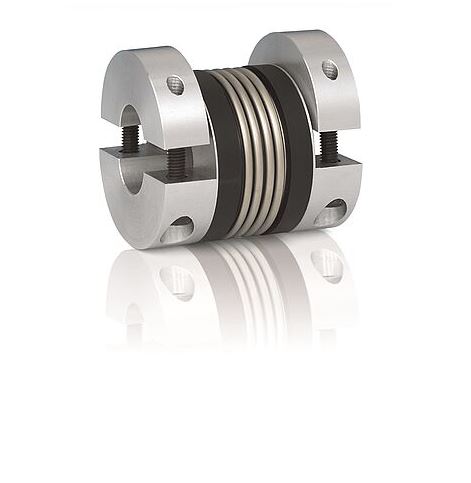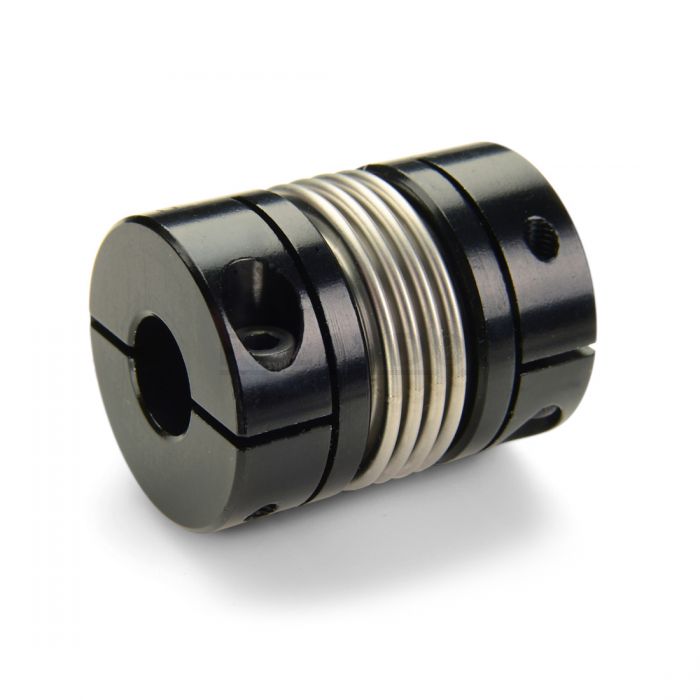Product Description
GRC Aluminum alloy bellows clamping coupling
Description of GRC Aluminum alloy bellows clamping coupling
>The material is aluminum alloy, and the middle bellows is made of stainless steel with excellent corrosion resistance
>Laser welding is used between bellows and shaft sleeve, with zero rotation clearance, suitable for CHINAMFG and reverse rotation
>Bellows structure can effectively compensate radial, angular and axial deviation
>Designed for servo motor stepper motor
>Fastening method of clamping screw
Dimensions of GRC Aluminum alloy bellows clamping coupling
| model parameter | common bore diameter d1,d2 | ΦD | L | L1 | L2 | L3 | N | F | M | tightening screw torque (N.M) |
| GRC-16×27 | 4,5,6,6.35,7,8 | 16 | 27 | 7.5 | 2 | 8 | 13.5 | 3 | M2.5 | 1 |
| GRC-20×32 | 5,6,6.35,7,8,9,9.525,10 | 20 | 32 | 7.2 | 2.8 | 12 | 18 | 3.5 | M3 | 1.5 |
| GRC-22.5×34 | 5,6,6.35,7,8,9,9.525,10,11,12 | 22.5 | 34 | 8.05 | 2.8 | 12.3 | 20.2 | 4.5 | M3 | 1.5 |
| GRC-25×37 | 6,6.35,7,8,9,9,9.525,10,12 | 25 | 37 | 9.5 | 3 | 12 | 20.2 | 4.5 | M3 | 1.5 |
| GRC-32×42 | 8,9,9.525,10,11,12,12.7,14,15 | 32 | 42 | 8 | 4 | 18 | 27.2 | 5.5 | M4 | 2.5 |
| GRC-40×55 | 8,9,9.525,10,11,12,12.7,14,15,16,17,18,19,20 | 40 | 55 | 11.5 | 6 | 20 | 34.5 | 6.5 | M5 | 7 |
| GRC-55×72 | 10,11,12,12.7,14,15,16,17,18,19,20,22,24,25 | 55 | 72 | 16.5 | 6 | 27 | 51.9 | 10 | M6 | 12 |
| GRC-65×81 | 10,11,12,12.7,14,15,16,17,18,19,20,22,24,25,28,30,32,35,38 | 65 | 81 | 19.5 | 7 | 28 | 60.5 | 10.5 | M6 | 12 |
| model parameter | Rated torque (N.M)* |
allowable eccentricity (mm)* |
allowable deflection angle (°)* |
allowable axial deviation (mm)* |
maximum speed rpm |
static torsional stiffness (N.M/rad) |
moment of inertia (Kg.M2) |
Material of shaft sleeve | surface treatment | weight (g) |
| GRC-16×27 | 0.8 | 0.1 | 1.5 | + 0.4 -1.2 | 9400 | 150 | 8.0×10-7 | High strength aluminum alloy | Anodizing treatment | 8 |
| GRC-20×32 | 1.5 | 0.15 | 2 | + 0.6 -1.8 | 7600 | 220 | 2.2×10-6 | 13 | ||
| GRC-22.5×34 | 1.8 | 0.15 | 2 | + 0.6 -1.8 | 6000 | 300 | 6.5×10-6 | 22 | ||
| GRC-25×37 | 2.0 | 0.15 | 2 | + 0.8 -1.8 | 6100 | 330 | 6.9×10-6 | 30 | ||
| GRC-32×42 | 2.5 | 0.2 | 2 | + 0.8 -2.5 | 4700 | 490 | 2.1×10-5 | 53 | ||
| GRC-40×55 | 6.4 | 0.2 | 2 | + 0.8 -2.5 | 4200 | 530 | 2.3×10-5 | 97 | ||
| GRC-55×72 | 12 | 0.2 | 2 | + 0.8 -2.5 | 3900 | 860 | 3.7×10-5 | 200 | ||
| GRC-65×81 | 18 | 0.2 | 2 | + 0.7 -2.5 | 3500 | 900 | 3.6×10-5 | 380 |
/* March 10, 2571 17:59:20 */!function(){function s(e,r){var a,o={};try{e&&e.split(“,”).forEach(function(e,t){e&&(a=e.match(/(.*?):(.*)$/))&&1

What are the Maintenance Requirements for Bellows Couplings to Ensure Reliable Performance?
Proper maintenance of bellows couplings is essential to ensure their reliable performance and extend their service life. Here are some maintenance requirements and practices for bellows couplings:
- Regular Inspection: Perform routine inspections of the bellows coupling to check for any signs of wear, damage, or misalignment. Look for cracks, tears, or deformation in the bellows element, as these issues can lead to coupling failure.
- Lubrication: In most cases, bellows couplings do not require lubrication. However, some specific applications or coupling designs may benefit from periodic lubrication of the shafts. Always follow the manufacturer’s guidelines regarding lubrication, as using the wrong type of lubricant can damage the coupling.
- Keep the Coupling Clean: Ensure that the bellows coupling and its surroundings are clean and free from debris. Dirt, dust, and foreign particles can accelerate wear and reduce the coupling’s performance.
- Avoid Overloading: Do not exceed the maximum torque and speed limits specified by the manufacturer. Overloading the coupling can cause premature failure and compromise the system’s performance.
- Address Misalignment and Shaft Movement: If misalignment or shaft movement occurs during operation, identify and correct the root cause promptly. Excessive misalignment or axial motion can put extra stress on the bellows and lead to premature failure.
- Inspect Fasteners: Check and tighten the fasteners, such as set screws or clamping screws, that secure the coupling to the shafts. Loose fasteners can cause the coupling to slip or shift, affecting its performance.
- Replace Damaged Couplings: If any signs of damage or wear are detected during inspection, replace the bellows coupling with a new one. Continuing to use a damaged coupling can result in catastrophic failure and potential damage to connected machinery.
- Follow Manufacturer’s Guidelines: Always follow the maintenance instructions provided by the coupling manufacturer. They may have specific recommendations for inspection intervals, cleaning methods, and other maintenance practices.
By following these maintenance practices, you can ensure that your bellows couplings remain in good condition and deliver reliable performance throughout their operational life. Regular inspections and proactive maintenance help identify potential issues early, allowing you to take corrective actions before they escalate into more significant problems.

How do Bellows Couplings Compare to Other Coupling Types, such as Flexible or Rigid Couplings?
Bellows couplings offer distinct advantages and characteristics that set them apart from other coupling types, such as flexible and rigid couplings. Here is a comparison of bellows couplings with other coupling types:
- Flexibility: Bellows couplings are a type of flexible coupling. They provide excellent angular and axial misalignment compensation while maintaining a high level of torsional rigidity. This flexibility helps to reduce stress on connected equipment and allows for smooth operation even in misaligned conditions.
- Compensation for Misalignment: Flexible couplings, including bellows couplings, can accommodate both angular and parallel misalignments. They are designed to allow a certain degree of relative movement between shafts, which helps prevent damage to shafts and connected equipment due to misalignment or vibration.
- Compactness: Bellows couplings are compact and lightweight, making them suitable for applications where space is limited. The absence of additional components, such as elastomeric elements found in other flexible couplings, contributes to their compact design.
- Torsional Stiffness: Compared to some other flexible couplings, bellows couplings offer higher torsional stiffness. This characteristic ensures efficient torque transmission and precise motion control, making them suitable for applications demanding high torsional rigidity.
- Backlash: Bellows couplings typically have minimal backlash due to the absence of mechanical play or components that can introduce free movement. This characteristic allows for precise positioning and control in motion systems.
- Electrical Isolation: Unlike rigid couplings, bellows couplings provide electrical isolation between shafts, making them ideal for applications where electrical continuity must be maintained or avoided between the connected components.
- Resonance Damping: Bellows couplings can help dampen vibrations and reduce resonance in rotating equipment. This characteristic contributes to smoother operation and prolongs the life of connected components.
On the other hand, rigid couplings are suitable for applications requiring precise shaft alignment and no flexibility. They provide a solid and direct connection between shafts, ensuring efficient torque transmission without any loss due to misalignment. However, rigid couplings cannot compensate for misalignment and are more prone to stress concentration in case of shaft misalignment or vibrations.
While flexible couplings, including bellows couplings, offer misalignment compensation and flexibility, they may have slightly lower torsional stiffness compared to rigid couplings. However, their ability to handle misalignments and provide damping characteristics often outweigh this consideration in many motion control applications.
In summary, bellows couplings combine flexibility, torsional stiffness, electrical isolation, and vibration damping features, making them a versatile choice for various precision motion control applications.

How do Bellows Couplings Accommodate Misalignment and Axial Motion between Shafts?
Bellows couplings are designed to accommodate misalignment and axial motion between shafts while maintaining accurate torque transmission. The key features that enable this flexibility are the bellows element and the coupling’s construction.
1. Bellows Element: The bellows element is a thin-walled, corrugated metal tube with deep convolutions. When torque is applied to the coupling, the bellows element flexes, allowing for angular misalignment between the driving and driven shafts. The corrugations in the bellows provide the necessary flexibility while maintaining the overall structural integrity of the coupling.
2. Axial Motion Compensation: Bellows couplings can also accommodate axial motion between shafts. When there is axial displacement, the bellows compresses or extends, effectively compensating for the relative movement of the shafts along the axial direction. This feature is particularly beneficial in applications where shafts experience thermal expansion or contraction during operation.
3. Single and Multi-Bellows Designs: Bellows couplings are available in both single and multi-bellows designs. Single-bellows couplings offer greater flexibility and are suitable for applications with relatively low misalignments and axial motion. On the other hand, multi-bellows couplings provide enhanced flexibility and can accommodate higher levels of misalignment and axial motion.
4. Zero Backlash: Bellows couplings are designed to have minimal or zero backlash. Backlash refers to the play or clearance between the coupling’s components. Zero backlash ensures that there is no lost motion when reversing the direction of rotation, making bellows couplings ideal for precision motion control applications.
5. Reducing Side Loads: To ensure optimal performance and longevity, it is essential to minimize side loads on bellows couplings. Excessive side loads can cause premature wear and fatigue in the bellows element, leading to reduced coupling life.
Overall, bellows couplings provide excellent flexibility and compensatory capabilities, making them a preferred choice in applications where misalignment and axial motion are expected. The ability to handle these factors without compromising torque transmission or introducing backlash makes bellows couplings suitable for various industries, including robotics, automation, aerospace, and semiconductor manufacturing.


editor by CX 2024-02-07
